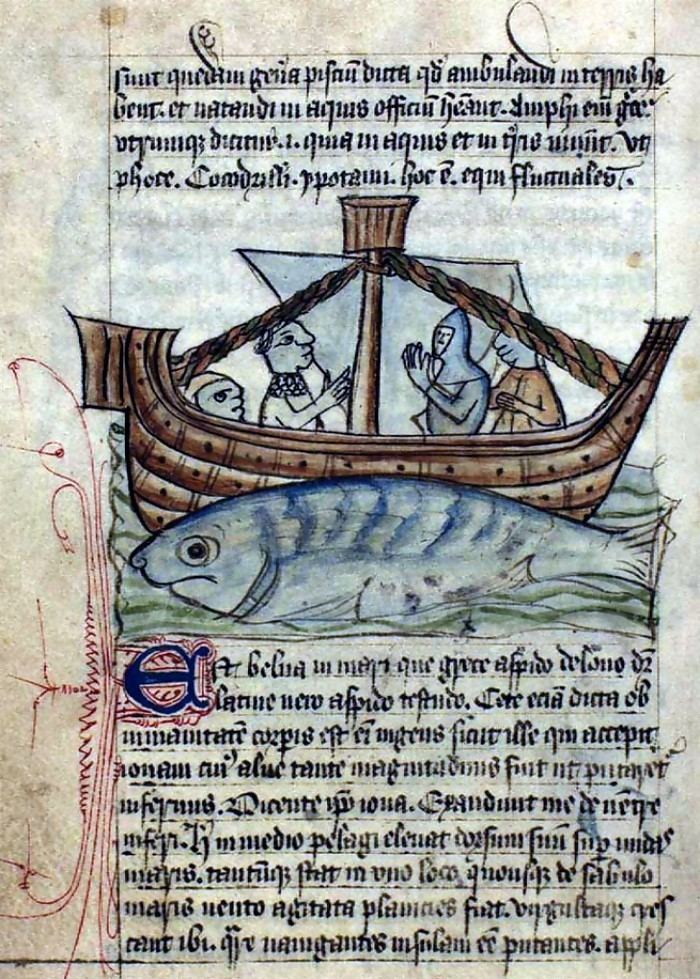 | ||
According to the tradition of the Physiologus and medieval bestiaries, the aspidochelone is a fabled sea creature, variously described as a large whale or vast sea turtle, and a giant sea monster with huge spines on the ridge of its back. No matter what form it is, it is always described as being huge where it is often mistaken for an island and appears to be rocky with crevices and valleys with trees and greenery and having sand dunes all over it. The name aspidochelone appears to be a compound word combining Greek aspis (which means either "asp" or "shield"), and chelone, the turtle. It rises to the surface from the depths of the sea, and entices unwitting sailors with its island appearance to make landfall on its huge shell and then the whale is able to pull them under the ocean, ship and all the people, drowning them. It also emits a sweet smell that lures fish into its trap where it then devours them. In the moralistic allegory of the Physiologus and bestiary tradition, the aspidochelone represents Satan, who deceives those whom he seeks to devour.
Contents
Accounts of seafarers' encounters with gigantic fish appear in various other works, including the Book of Jonah, Pinocchio, and the Baron Munchausen stories.
In the Physiologus
One version of the Latin text of the Physiologus reads:
"There is a monster in the sea which in Greek is called aspidochelone, in Latin "asp-turtle"; it is a great whale, that has what appear to be beaches on its hide, like those from the sea-shore. This creature raises its back above the waves of the sea, so that sailors believe that it is just an island, so that when they see it, it appears to them to be a sandy beach such as is common along the sea-shore. Believing it to be an island, they beach their ship alongside it, and disembarking, they plant stakes and tie up the ships. Then, in order to cook a meal after this work, they make fires on the sand as if on land. But when the monster feels the heat of these fires, it immediately submerges into the water, and pulls the ship into the depths of the sea.Such is the fate of all who pay no heed to the Devil and his wiles, and place their hopes in him: tied to him by their works, they are submerged into the burning fire of Gehenna: for such is his guile."
In The Whale
A similar tale is told by the Old English poem The Whale, where the monster appears under the name Fastitocalon. This is apparently a variant of Aspidochelone, and the name given to the Devil. The poem has an unknown author, and is one of three poems in the Old English Physiologus, also known as the Bestiary, in the Exeter Book, folio 96b-97b, that are allegorical in nature, the other two being The Phoenix and The Panther. The Exeter book is now in the Exeter Cathedral library. It is possible that this book was intended to be put in the gospels because some people believe it was written by a saint and that it is about many different Christian ideas, such as the devil, God, and Christ’s death and resurrection. The book has suffered from multiple mutilations and it is possible that some of the manuscript is missing. It is believed that the book had been used as a “beer mat”, a cutting board, and suffered other types of mutilation by its previous owners. The Physiologus has gone through many different translations into many different languages throughout the world. It is possible that the content has also been changed throughout the centuries.
Nu ic fitte gen ymb fisca cynnwille woðcræfte wordum cyþan
þurh modgemynd bi þam miclan hwale.
Se bið unwillum oft gemeted,
frecne ond ferðgrim, fareðlacendum,
niþþa gehwylcum; þam is noma cenned,
fyrnstreama geflotan, Fastitocalon.Is þæs hiw gelic hreofum stane,
swylce worie bi wædes ofre,
sondbeorgum ymbseald, særyrica mæst,
swa þæt wenaþ wægliþende
þæt hy on ealond sum eagum wliten,
ond þonne gehydað heahstefn scipu
to þam unlonde oncyrrapum . . .
The moral of the story remains the same:
Swa bið scinna þeaw,deofla wise, þæt hi drohtende
þurh dyrne meaht duguðe beswicað,
ond on teosu tyhtaþ tilra dæda. . .
In The Adventures of Tom Bombadil, J. R. R. Tolkien made a little verse that claimed the name "Fastitocalon" from The Whale, and told a similar story:
Look, there is Fastitocalon!An island good to land upon,
Although 'tis rather bare.
Come, leave the sea! And let us run,
Or dance, or lie down in the sun!
See, gulls are sitting there!
Beware!
As such, Tolkien imported the traditional tale of the aspidochelone into the lore of his Middle-earth.
Jasconius
A similar monster appears in the Legend of Saint Brendan, where it was called Jasconius. Because of its size, Brendan and his fellow voyagers mistake it for an island and land to make camp. They celebrate Easter on the sleeping giant's back, but awaken it when they light their campfire. They race to their ship, and Brendan explains that the moving island is really Jasconius, who labors unsuccessfully to put his tail in its mouth.
The same tale of a sea monster that is mistaken for an island is told in the first voyage of Sinbad the Sailor in The Book of One Thousand and One Nights.
